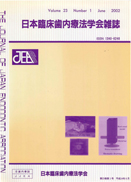Volume 16, Issue 2
Displaying 1-11 of 11 articles from this issue
- |<
- <
- 1
- >
- >|
Review Article
-
1995Volume 16Issue 2 Pages 159-167
Published: 1995
Released on J-STAGE: June 30, 2019
Download PDF (9920K) -
1995Volume 16Issue 2 Pages 168-174
Published: 1995
Released on J-STAGE: June 30, 2019
Download PDF (7275K) -
1995Volume 16Issue 2 Pages 175-190
Published: 1995
Released on J-STAGE: June 30, 2019
Download PDF (14742K) -
1995Volume 16Issue 2 Pages 191-200
Published: 1995
Released on J-STAGE: June 30, 2019
Download PDF (7455K)
Original Article
-
1995Volume 16Issue 2 Pages 201-206
Published: 1995
Released on J-STAGE: June 30, 2019
Download PDF (3690K) -
1995Volume 16Issue 2 Pages 207-210
Published: 1995
Released on J-STAGE: June 30, 2019
Download PDF (2971K) -
1995Volume 16Issue 2 Pages 211-217
Published: 1995
Released on J-STAGE: June 30, 2019
Download PDF (6834K) -
1995Volume 16Issue 2 Pages 218-222
Published: 1995
Released on J-STAGE: June 30, 2019
Download PDF (3102K)
Case Report
-
1995Volume 16Issue 2 Pages 254-260
Published: 1995
Released on J-STAGE: June 30, 2019
Download PDF (4240K) -
1995Volume 16Issue 2 Pages 261-264
Published: 1995
Released on J-STAGE: June 30, 2019
Download PDF (983K) -
1995Volume 16Issue 2 Pages 265-268
Published: 1995
Released on J-STAGE: June 30, 2019
Download PDF (1564K)
- |<
- <
- 1
- >
- >|
